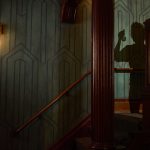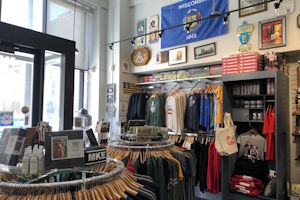2006-10 Vital Source Mag – October 2006
Jeremy Enigk
By Nikki Butgereit The new album from Jeremy Enigk, former singer and primary songwriter of Sunny Day Real Estate, is a melancholy trip to the depths of emo. Unfortunately, it never makes its way back from the pits. The album begins with the instrumental track “A New Beginning,” a jubilant symphony of violins and dramatic chiming bells. Here is where the pep begins and ends as the remainder of the album has a folksy, contemplative, philosophical vibe that’s rather depressing. Enigk’s raspy vocals are reminiscent of Perry Farrell, with a touch more whine. While that style fits in perfectly with the quietly dreary tone of the record, it becomes overwhelmingly grating as the songs tick by. Musically, the album is long on depth. The songs layer violin and mandolin on top of piano and guitar. The melodies are sweeping and sometimes powerful, but even the “upbeat” songs are downers. “City Tonight” has the closest thing to a driving rock beat you’ll find on this album, but it still keeps the pace at a slow drag. Enigk’s first solo venture in 10 years has none of the vigor and punch of the early Sunny Day Real Estate, which is unfortunate. While the songs are solid and the compositions lush, the moony lyrics and snail’s pace make the album exhausting to listen to and difficult to enjoy.
Oct 1st, 2006 by Vital ArchivesOctober Records Releases
By Erin Wolf OCTOBER 3 Beck The Information Interscope Jim Brickman Escape SLG/Savoy Lindsey Buckingham Under the Skin Reprise Cities Variations Yep Roc The Datsuns Smoke & Mirrors U.K. – V2 The Decemberists The Crane Wife Capitol Evanescence The Open Door Wind-up The Dears Gang of Losers V2 Jet Shine On Atlantic The Killers Sam’s Town Island The Kooks Inside In/Inside Out Astralwerks Amos Lee Supply and Demand Blue Note Sean Lennon Friendly Fire Capitol Pernice Brothers Live a Little Ashmont Rodrigo y Gabriela Self-titled ATO/RCA George Strait It Just Comes Natural MCA Nashville …and you will know us by the Trail of Dead So Divided Interscope Robyn Hitchcock and the Venus 3 Olé! Tarantula! Yep Roc The Hold Steady Boys and Girls in America Vagrant OCTOBER 10 The Be Good Tanyas Hello Love Nettwerk The Blood Brothers Young Machetes V2 Chin Up Chin Up This Harness Can’t Ride Anything Suicide Squeeze Califone Roots & Crowns Thrill Jockey Lloyd Cole Antidepressant One Little Indian Albert Hammond Jr. (Strokes guitarist) Yours to Keep U.K. – Rough Trade The Memory Band Apron Strings: Songs of False Love and True Bloodshot Oxford Collapse Remember the Night Parties Sub Pop Robert Pollard Normal Happiness Merge OCTOBER 17 Patti LaBelle The Gospel According to Patti LaBelle Universal The Slits Revenge of the Killer Slits SAF Clinic Visitations U.K. – Domino Diddy Press Play Bad Boy/Warner Jeremy Enigk World Waits Sony BMG Me First and the Gimme Gimmes Love Their Country Fat Wreck Chords Badly Drawn Boy Born in the U.K. XL/Astralwerks OCTOBER 24 The Blow Paper Television K Converge No Heroes Epitaph The Heart Attacks Hellbound & Heartless Hellcat/Epitaph John Legend Once Again Columbia The Walkmen Pussy Cats Starring the Walkmen Record Collection My Chemical Romance The Black Parade Reprise Brian Setzer 13 Surfdog Sparta Threes Hollywood OCTOBER 31 The Clipse Hell Hath No Fury J Copeland Eat, Sleep, Repeat The Militia Group Dead Poetic Vices Tooth & Nail Jim Jones Bright Lights Big City Koch Barry Manilow The Greatest Songs of the Sixties Arista Aimee Mann One More Drifter in the Snow Super Ego Meat Loaf Bat Out of Hell III: The Monster is Loose Virgin Willie Nelson & The Cardinals Songbird Lost Highway Paul Wall Get Money, Stay True Atlantic The Who Endless Wire Universal Republic
Oct 1st, 2006 by Vital ArchivesIndigo Girls
By Jon M. Gilbertson As cult artists go, The Indigo Girls are perhaps halfway between Richard Thompson and The Ramones. Unlike Thompson, Amy Ray and Emily Saliers have had a couple of hits (although the big ones go back a decade and a half); like him, they have a dependable core audience. Like The Ramones, they have not been encouraged to vary their identifiable style; unlike The Ramones, they cannot claim to have invented, or at any rate, popularized it. For The Indigo Girls, this tricky situation means that minor distinctions take on magnified importance: one disastrous track throws an entire album out of whack, but absolute familiarity breeds boredom if not outright contempt. Under the circumstances, Despite Our Differences is a qualified success. As usual, Ray slips into the role as the plainer singer and more direct thinker of the two (the driving “Money Made You Mean” represents her side), with Saliers being the more sweetly melodic and more poetic (the waltzing “Lay My Head Down” epitomizes her side). Depending on who’s out front, their harmonies have either mid-autumn crispness or mid-spring breeziness. Really, that’s about it. Pink – returning the kindness the duo paid her by appearing on her album I’m Not Dead earlier this year – juices up the loudest track, “Rock and Roll Heaven’s Gate.” Famed producer Mitchell Froom manages, for once, not to bend the sound toward his quirks. True believers will love it. Casual fans will like it. People outside the cult… who knows?
Oct 1st, 2006 by Vital ArchivesBob Dylan
By Blaine Schultz With Modern Times, Bob Dylan finds himself inhabiting the itinerant bluesmen’s spirits he merely impersonated when he cut his first album in 1962. As with the masterful Love and Theft, Dylan immerses himself in American music forms, touching on blues, old-timey country and Tin Pan Alley pop, and lets his band rip into these templates, reinventing them in his own image. If these songs sound familiar it is simply because Dylan is not shy about borrowing generously – a Muddy Waters line here, a slide guitar lick there – from source materials that were magpied plenty of times before he got to them. But like Miles Davis and Bill Monroe, Dylan reconfigures the very DNA of the music. This is the second album in a row Dylan has chosen to record with his current touring group and, musically, Modern Times excels when the players work in their signature driving, roadhouse blues that allows for real-time interaction and bits of improvisation. Not unlike his legendary work with The Band, this lineup is a stellar example of how songs are treated in the hands of sympathetic players. Unfortunately, in Dylan’s tour of the American songbook he seems to have developed a jones for crooners. While his cragged voice woks great for the Old Testament cane-stompers, there’s too much Bing Crosby included here; that’s my lone caveat. Consumer note: some pressings include a DVD of four fantastic performances, and orders from his website include a CD of Dylan’s Theme Time satellite radio show with his hilarious commentary on baseball-themed tunes.
Oct 1st, 2006 by Vital ArchivesJet
By Jon M. Gilbertson There was no denying that Jet’s 2003 debut, Get Born, was energetic. That distinguished both the Aussie band and their songs from Oasis, with whom they have otherwise shared numerous characteristics: brotherly consanguinity (the Cesters vs. the Gallaghers), a producer (Dave Sardy) and a fetish for wearing yesterday’s fashions as though they were today’s. Not a lot has changed on Jet’s follow-up, Shine On, but it is a stronger album because of how every little evolution accumulates over the course of its 15 tracks. The most noticeable improvement lies in the band’s ability to vary tempos. Get Born’s best songs were its faster ones, period, and never mind that the clumsy “Sexy Sadie” rewrite “Look What You’ve Done” was a hit. Now, whether tearing through the mid-tempo AC/DC-derived “Stand Up,” gently developing a Pink Floyd tangent via the title track, or throwing noise all over the garage in “Rip It Up,” Jet sounds just that significant bit less reverent of their sources. As frontman and lead singer Nic Cester spearheads the turn toward determined looseness, both his shredded-speaker scream and his Abbey Road-era croon have gained something akin to personality. Mostly, though, Jet and Sardy don’t tamper with what worked before: Chris Cester’s Ringo-solid drums, Mark Wilson’s power-trio bass (which sounds heavy in the quartet setting) and Nic Cester and Cam Muncey’s too-perfect guitar interplay. Yes, what worked before for Jet was actually what worked 35 years before Get Born got born. It still works, and probably shall as long as cheeky bastards like this have the energy and arrogance of youth.
Oct 1st, 2006 by Vital ArchivesShoot from the hip
By Jon Anne Willow You may have heard of Cedar Block, Milwaukee’s premiere presenter of offbeat creative events with an emphasis on group participation. You may have heard of Saul Leiter, the New York street photographer who blazed the trail for the use of color in art photography in the mid 20th century. And you may have heard of lomography… or not. But even if none of these are familiar to your ear, you will surely have heard of the Milwaukee Art Museum (MAM) and of Milwaukee Street in Milwaukee. And whether you’ve heard of all these things or only the last two, you will soon see them brought together in what is perhaps one of the most interesting collaborations of local and national photography this year. In Living Color: The Photographs of Saul Leiter opened at the Art Museum on September 28. Unlike his ersatz contemporaries in Abstract Expressionism, Mark Rothko and Richard Pousette-Dart, Leiter’s work wasn’t embraced by the formal art community until recently. But like Fellini or Bergman among filmmakers, his influence has been felt among photographers for decades. And now Milwaukee will be first to acknowledge his contribution to the form with the first-ever major exhibit for the 82-year-old photographer. As early as the late 40s, Leiter worked primarily in color, shooting scenes of New York City that stunningly captured urban life in saturated frames and off-kilter focus. At that time, color photography was not only expensive to process, but viewed by many as a baser form of the medium. Leiter’s photos further insulted the “art world” by presenting technical “imperfections” rather as augmentation, an approach with which he was rewarded by resounding silence from curators around the world. To his vast credit, Leiter didn’t care: he continued to ply his trade his own way, presenting his work as slide shows with his photographs blown up to the scale of full-size paintings. The MAM exhibit will include a room devoted to a digital slide show in that vein, along with around 70 color prints, a selection of black and white photos and four of his watercolor/govache paintings. Enter Cedar Block, the brainchild of Brent Gohde, ostensibly a member of Milwaukee’s emerging DIY Art Movement. (Though the city has yet to be recognized nationally as a haven for such, we are confident it will, so we’ll just say it now). Gohde, like his peers, is firmly committed to the principle that there is a place for every artist who wants to work, even if their talents and opportunities don’t fall into traditionally accepted tracks. To that end, Cedar Block stages unusual events, from Weird Science Fairs to essay contests, and now an exhibit of lomography-inspired photographs by local artists in conjunction with the Leiter exhibit. “There’s never been a voice that shouldn’t be heard,” says Gohde. “These events provide a venue for the non-traditional artist to show their work, have it displayed in a world-class museum. My fondest hope is reaching further quarters of the Milwaukee community […]
Oct 1st, 2006 by Jon Anne WillowWhat kind are you?
By Jon Anne Willow Dear Readers, My boyfriend is my favorite kind of conservative. A drive past a “Give Peace a Chance” yard sign is enough to get him started. “I don’t want to hear from anyone about being unhappy with the way things are going unless they have a plan to change it,” is one common complaint. If I mention that he himself is unhappy with “the way things are going” he is quick to point out that he’s not complaining. (God forbid we ever end up at a red light behind a “Republicans for Voldemort” bumper sticker: The only thing that bothers him more than liberals without a plan is fantasy andscience fiction.) When afforded these impromptu opportunities to engage in political debate, the conversation plays out predictably. He lays out his argument with the usual tent stakes of the superior organizational power of the Republicans and his support of decisive action and a clear agenda over ideological drift and Tower-of-Babel pluralism. His resolve typically begins to falter, though, when questioned directly on whether the decisive actions to which he refers represent sound policy, and whether the clear social and moral agenda of his party truly adhere to the founding principles of Republicanism. Like many conservative individuals, he is a person of common sense, secretly disappointed in just how far his party has strayed from its core values. I’m pretty sure I’m also my boyfriend’s favorite kind of liberal. I pound the tent stakes of our nation’s fall from grace: of a once-compassionate government which no longer guards the interests of its most vulnerable, which thumbs its nose at the rest of the world’s economic and social interests, which aggressively seeks to erode such basic personal freedoms as privacy and reproductive choice. My resolve typically begins to falter, though, when he points out that despite the fact that many Americans on both sides of the political fence share my views, my party has done nothing to effect change except make the aforementioned charges. Yes, Democrats are working hard to win back Congressional seats in these midterm elections on a vague platform of curing these ills, but the party was beset on all sides for over a decade before it started to retaliate with any force. “The war has been such an effective distraction,” I attempt to argue. “People don’t want to buck the leadership when faced with such a crisis.” I even sometimes add lamely, “Besides, these things take time.” (God forbid we end up at a red light behind a “Democrats Have Moral Values, Too” bumper sticker. The only thing that bothers me more than liberals without a plan is whining statements of the obvious.) Not so secretly, I am also disappointed in how far my party has strayed from its core values. But what is the solution? The events of the last five years have shown in stark relief just how little difference there is between elected officials. Even if given a free pass on the […]
Oct 1st, 2006 by Jon Anne Willow



















